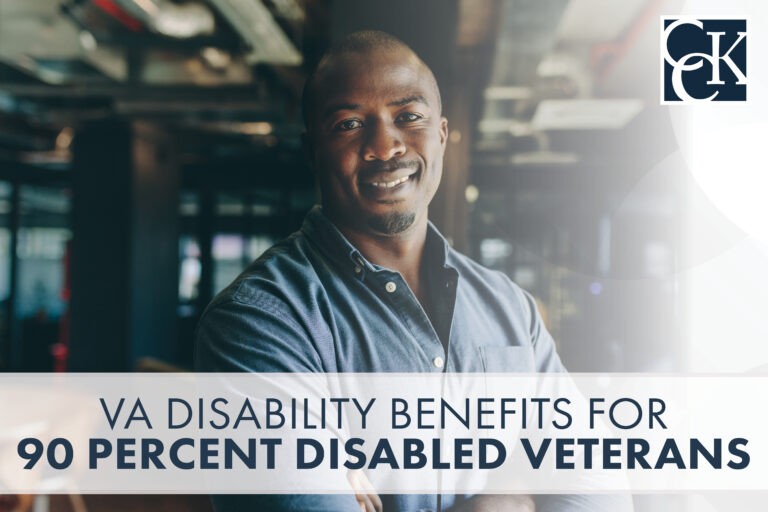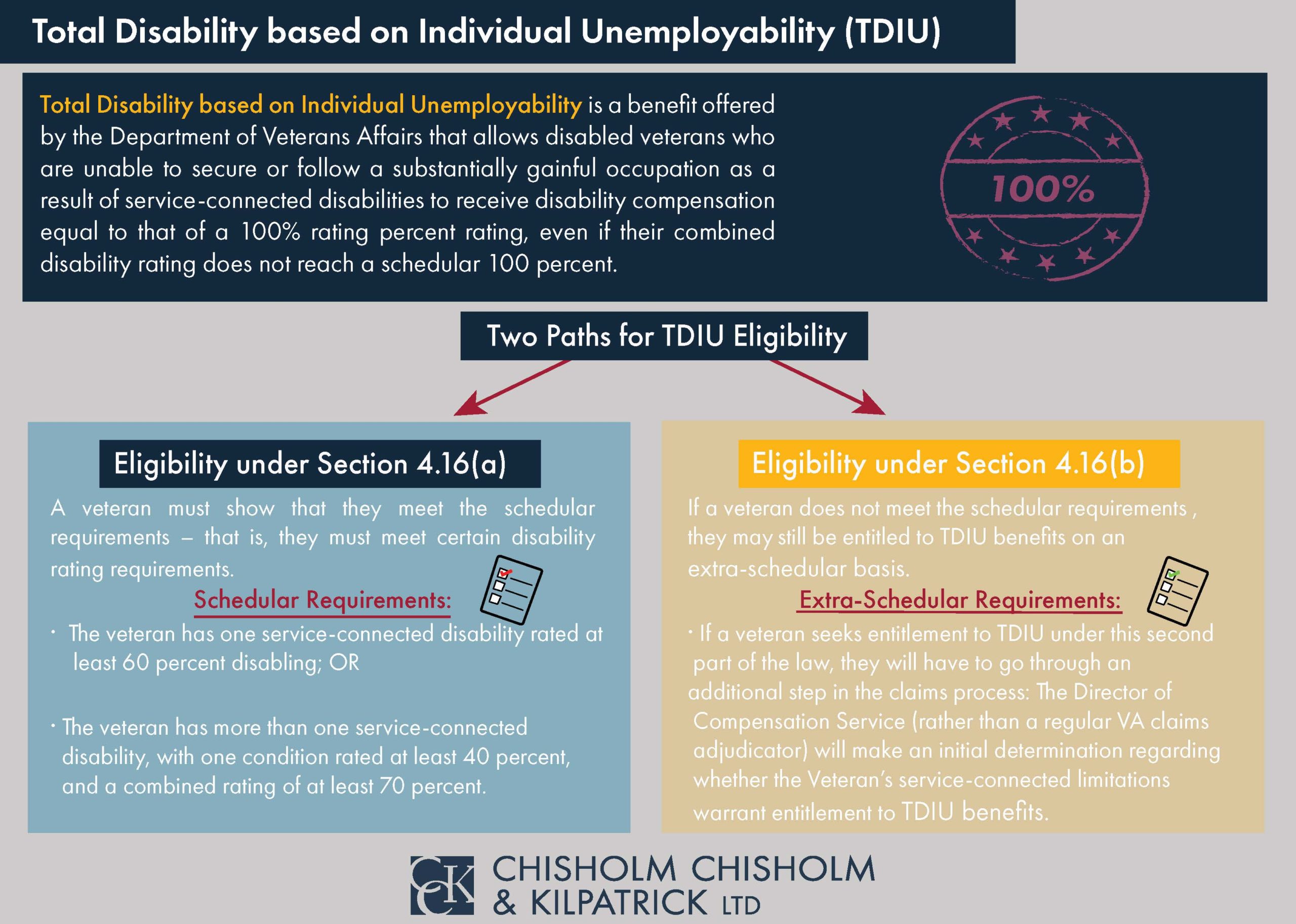VA Disability Benefits for 90 Percent Disabled Veterans

CCK Law: Our Vital Role in Veterans Law
A 90 percent disability rating from VA entitles a veteran to both monetary compensation and additional benefits. In this article, we will discuss the 2024 compensation, benefits, and appeal options for veterans with a VA disability rating of 90 percent.
Veterans should research their VA ratings carefully. If the compensation and benefits do not align with their needs, veterans may want to consider one of the various ways to increase their rating.
VA Disability Compensation for 90 Percent Ratings
The core disability benefit for non-zero ratings is monetary compensation. Note that for 2024, the cost-of-living-adjustment (COLA) was an increase of approximately 3.2 percent, resulting in a rise in compensation for disabled veterans.
As of December 1, 2023, veterans rated as 90 percent disabled without any qualifying dependents began receiving $2,241.91 in VA disability compensation. Alternatively, if the veteran has qualifying dependent(s), the monthly compensation amounts would be as follows:
- Veteran and Spouse — $2,428.91 (if spouse requires aid and attendance, add $172.00)
- Veteran, Spouse, and Parent — $2,578.91
- Veteran, Spouse, and Parents — $2,728.91
- Veteran and Parent — $2,391.91
- Veteran and Parents — $2,541.91
- Veteran, Spouse, and Child — $2,565.91
- Veteran and Child — $2,366.91
- Veteran, Spouse, Parent, and Child — $2,715.91
- Veteran, Spouse, Parents, and Child — $2,865.91
- Veteran, Parent, and Child — $2,516.91
- Veteran, Parents, and Child — $2,666.91
For each additional child under the age of 18, veterans who are rated as 90 percent disabled can add $93 to their monthly compensation amount. Moreover, for each additional schoolchild over the age of 18, veterans who are 90 percent disabled can add $301 to their monthly compensation amount.
Additional Benefits for 90 Percent Disabled Veterans
In addition to monthly compensation, 90 percent disabled veterans are entitled to many other VA benefits. Veterans can find and compare some additional benefits for different ratings using VA’s “Service Connected Matrix” chart. Neither VA’s list nor the list below is intended to be exhaustive.
One of the unique benefits for veterans in the 60-90 percent disability rating range is potential eligibility for individual unemployability. Other potential benefits are detailed below.
VA Health Care for 90 Percent Disabled Veterans
When veterans apply for VA health care, VA will assign them to one of eight priority groups. These priority groups are based on the following:
- Military service history
- VA disability rating
- Income level
- Whether the veteran qualifies for Medicaid
- Other benefits veterans may be receiving (e.g., VA pension benefits)

Veterans rated as 90 percent disabled meet eligibility requirements for Health Care Priority Group 1. This group includes the following benefits:
- Preventive care
- Inpatient (hospitalization) services
- Ancillary services
- Mental health care
- Geriatrics and extended care
- Medical equipment/prosthetic items and aids
- Medication/supplies
- Dental care
- Nursing home placement
- Medically-related travel benefits
- Eyeglasses
- Hearing aids
- Automotive adaptive equipment (under certain conditions)
- Home improvement and structural alteration grants (under certain conditions)
- Dependents’ health care (if not eligible under TRICARE)
- Emergency care at a non-VA facility (under certain conditions)
- Foreign medical care (for service-connected and secondary conditions)
VA also has a healthcare travel reimbursement program to reimburse veterans and caregivers for mileage and other travel expenses to and from approved healthcare appointments.
Disability-Related Clothing Allowance
There are certain situations in which 90 percent disabled veterans qualify for a clothing allowance. Specifically, veterans with a service-connected condition that requires prosthetics or orthopedic appliances or topical medications that lead to additional wear and tear on clothing may be eligible for an additional yearly monetary benefit.
Disability-Related Home Improvement and Structural Alteration Grants
Home improvement and structural alteration grants are available primarily to veterans with service-connected conditions (and some with non-service-connected conditions) who require home improvements or alterations for the continuation of treatment. Here, eligibility requires a medical determination that such improvement and alterations are necessary for effective medical treatment of the condition.
Life Insurance for Veterans 90 Percent Disabled
The Service-Disabled Veterans Life Insurance (S-DVI) offers low-cost insurance coverage to eligible service members and veterans. Veterans who meet requirements for S-DVI can receive up to $10,000 of coverage and $30,000 of supplemental coverage. The premium amount that veterans pay for S-DVI coverage depends on age, type of plan (term or permanent), and the amount of coverage.
Veterans’ Group Life Insurance (VGLI) is a benefit that typically follows Service Members’ Group Life Insurance (SGLI), provided the veteran meets certain qualifications. Veterans who continue to pay the premiums for VGLI after leaving service can keep their insurance. Veterans can receive between $10,000 and $40,000 in life insurance benefits, based on the amount of SGLI coverage they had when they left the military.
Vocational Readiness and Employment (VR&E)
Veterans who have significant disabilities but a continued need for employment may be interested in VA’s Vocational Readiness and Employment (VR&E) program. VR&E helps disabled veterans and service members increase their likelihood of obtaining employment.
VR&E provides a range of career services, including:
- Career counseling and rehabilitation planning for employment
- Job training, job-seeking skills, résumé development, and other work-readiness assistance
- On-the-job-training, apprenticeships, and non-paid work experience
Free Tax Preparation for Disabled Veterans
The IRS’s Volunteer Income Tax Assistance (VITA) and Tax Counseling for the Elderly (TCE) programs assist thousands of veterans in preparing their taxes for free every year.
The IRS works with local community groups to train and certify VITA and TCE volunteers. These volunteers then help qualifying disabled veterans prepare their taxes. VITA and TCE also provide free electronic filing.
Home Loan Guarantee
VA provides home loan guarantees to help veterans buy, repair, build, or keep a home. In general, VA home loans are provided by private lenders (banks and mortgage companies) and are guaranteed by VA so a veteran or service member can get more favorable terms.
VA has multiple types of home loans for different situations. For example, Interest Rate Reduction Refinance Loans (IRRRL) allow veterans to refinance their current loan under new terms, such as a mortgage payment or interest rate. IRRRLs can also give veterans the opportunity to move their loan from an adjustable or variable interest rate to a fixed rate.
Regardless of the situation, VA’s goal for all home loan programs is to secure lower interest rates for veterans’ loans and allow lower down payments for their home purchases whenever possible.
Burial Benefits
For service-related deaths, VA will pay up to $2,000 toward burial expenses for deaths on or after September 11, 2001, or up to $1,500 for deaths before September 11, 2001. If the veteran is buried in a VA national cemetery, then some or all of the cost of transporting the deceased veteran may be reimbursed.
On the other hand, for non-service-related deaths, VA will pay up to $796 toward burial and funeral expenses for deaths on or after October 1, 2019 (if hospitalized by VA at time of death), or $300 toward burial and funeral expenses (if not hospitalized by VA at time of death), and a $796 plot-interment allowance (if not buried in a national cemetery).
For surviving spouses of 90 percent disabled veterans to qualify for burial benefits, the following must be true:
- You paid for a veteran’s burial or funeral, and
- You have not been reimbursed by another government agency or some other source, such as the deceased veteran’s employer, and
- The veteran was discharged under conditions other than dishonorable, and
- The veteran died because of a service-related disability, or
- The veteran was receiving VA pension or compensation at the time of death, or
- The veteran was entitled to receive VA pension or compensation, but decided not to reduce their military retirement or disability pay, or
- The veteran died while hospitalized by VA, or while receiving care under VA contract at a non-VA facility, or
- The veteran died while traveling under proper authorization and at VA expense to or from a specified place for the purpose of examination, treatment, or care, or
- The veteran had an original or reopened claim pending at the time of death and has been found entitled to compensation or pension from a date prior to the date of death, or
- The veteran died on or after October 9, 1996, while a patient at a VA-approved state nursing home.
VA Pension
VA Pension, or Veterans Pension, is a tax-free monthly benefit for certain low-income, wartime veterans, including those who are rated as 90 percent disabled.

Even though it is called a pension, the benefit has no relation to the number of years served. Rather, it is based on financial need, disability, and/or age. Veterans who are 90 percent disabled may be eligible to receive VA pension benefits if they were discharged under conditions other than dishonorable and:
- Started on active duty before September 8, 1980, and served at least 90 days on active duty with at least one day during wartime, or
- Started on active duty as an enlisted person after September 7, 1980, and served at least 24 months or the full period for which they were called or ordered to active duty (with some exceptions) with at least one day during wartime
AND:
- Veteran’s “countable family income” and net worth are below a yearly limit set by law (i.e., the Maximum Annual Pension Rate)
AND at least one of these is true:
- Veteran is at least 65 years old, or
- Veteran has a permanent and total (100%) disability, or
- Veteran is a patient in a nursing home for long-term care because of a disability, or
- Veteran is getting Social Security Disability Insurance or Supplemental Security Income
Other Considerations for 90 Percent Disabled Veterans
Increasing VA Disability Rating from 90 Percent to 100 Percent
A 90 percent rating represents a significant degree of disability. Veterans who qualify as 90 percent disabled often ask us whether they may be able to increase their disability rating from 90 percent to 100 percent, perhaps through mechanisms like Total Disability Based on Individual Unemployability (TDIU).
Appeals and TDIU are complex areas of veterans law. If you feel that you may be eligible, consider contacting an experienced, VA-accredited law firm. Note that CCK offers complimentary case evaluations.

Concurrent Retired and Disability Pay
Eligible veterans who are rated as 90 percent disabled may qualify for concurrent retired and disability pay (CRDP). Without CRDP, veterans’ VA compensation is subtracted from their retired pay to avoid “double-dipping.” This subtracted pay is called the VA waiver or VA offset. CRDP eliminates the VA waiver, allowing the veteran to receive the full amount of both types of compensation.
Veterans will not receive a separate check for CRDP. Instead, the monthly check they receive from the Defense Finance and Accounting Service (DFAS), the administrator of military retired pay, will be increased from the docked amount to their full retired pay.
Since it is a direct restoration of the VA waiver, CRDP essentially counts as service retired pay. There is no application process for CRDP. If veterans meet the eligibility requirements, DFAS will automatically eliminate the VA waiver, thereby restoring retired pay.
To be eligible for CRDP, veterans must:
- Be receiving retired pay and VA compensation, and
- Be a 20-year (or more) retiree, and
- Have a service-connected condition rated 50 percent or higher.
State Benefits for 90 Percent Disabled Veterans
Veterans rated at 90 percent disabled should also look into state-offered benefits, which may include:
- Educational discounts or free tuition at local universities
- Homeowners tax exemptions
- Veteran housing programs (i.e., assisted living, retirement villages)
- Long-term nursing facilities
- Property tax exemptions
- DAV state license plates/vehicle registration
- Free admission to state parks
- Discounts on hunting and fishing licenses
- Waiver of certain state fees (e.g., tolls, parking, permits, business, or driver’s licenses, etc.)
It is important to note that each state may have different qualification requirements. To explore more state-offered benefits, veterans should research their state specifically.
Do You Disagree with Your VA Disability Rating?
Do not be discouraged if you receive an unfavorable rating on your initial disability claim. As an enormous bureaucracy with a serious backlog of cases, VA frequently makes negative decisions based on minor factors in claims, leading to significant delays or inadequate benefits.
You may also find that your conditions have worsened over time or been complicated by secondary conditions caused by your original service-connected disability. These are valid circumstances to consider revisiting your original rating.
If any of these situations apply to you, consider asking an experienced, VA-accredited law firm like Chisholm Chisholm & Kilpatrick for a free case evaluation. Note that timing can be highly sensitive with appeals, so please contact us as soon as possible.
About the Author
Share this Post

